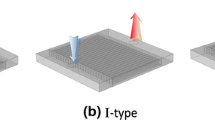Abstract
Microchannels are at the forefront of today’s cooling technologies. They are widely being considered for cooling of electronic devices and in micro heat exchanger systems due to their ease of manufacture. One issue which arises in the use of microchannels is related to the small length scale of the channel or channel cross-section. In this work, the maximum heat transfer and the optimum geometry for a given pressure loss have been calculated for forced convective heat transfer in microchannels of various cross-section having finite volume for laminar flow conditions. Solutions are presented for 10 different channel cross sections: parallel plate channel, circular duct, rectangular channel, elliptical duct, polygonal duct, equilateral triangular duct, isosceles triangular duct, right triangular duct, rhombic duct and trapezoidal duct. The model is only a function of the Prandtl number and the geometrical parameters of the cross-section, i.e., area and perimeter. This solution is performed with two exact and approximate methods. Finally, in addition to comparison and discussion of these two methods, validation of the relationship is provided using results from the open literature.
Similar content being viewed by others
References
D. B. Tuckerman and R. F. Pease, High-performance heat sinking for VLSI, IEEE Electron Device Lett., 5 (1981) 126–129.
M. Bahrami, M. M. Yavanovich and J. R. Culham, Pressure drop of fully developed laminar flow in microchannels of arbitrary cross-section, Transactions of the ASME, 128 (2006).
A. Bejan and E. Sciubba, The optimal spacing of parallel plates cooled by forced convection, Int. J. Heat Mass Transfer, vol. 35 (1992) 3259–3264.
S. Petrescu, Comments on the optimal spacing of parallel plates cooled by forced convection, Int. J. Heat Mass Transfer, 37 (1994) 1283.
A. Yilmaz, O. Buyukalaca and T. Yilmaz, Optimum shape and dimensions of ducts for convective heat transfer in laminar flow at constant wall temperature, Int. J. Heat Mass Transfer, 43 (2000) 767–775.
A. Bejan, Shape and structure, from engineering to nature, Cambridge University Press, Cambridge, K, 2000 35–37.
A. Bejan, Convection heat transfer, Wiley, New York, NY, 2004 136–141.
R. K. Shah and A. L. London, Laminar flow forced convection in ducts, Academic Press, NY, 1978 78–283.
R. K. Shah and M. S. Bhatti, Laminar convective heat transfer in ducts, in S. Kakac, R. S. Shah and W. Aung, Handbook of single-phase convective heat transfer. Wiley, New York, NY, (1987).
R. K. Shah, Laminar flow friction and forced convection heat transfer in ducts of arbitrary geometry, Int. J. Heat Mass Transfer, 18 (1975) 849–862.
Author information
Authors and Affiliations
Corresponding author
Additional information
This paper was recommended for publication in revised form by Associate Editor Jae Dong Chung
Omid Asgari received his B.S. in Mechanical Engineering from Karaj University, IRAN, in 2005. He then received his M.S. degree from Sharif university of Technology in 2007. Mr. Asgari is currently a PHD student at the School of Mechanical Engineering at Sharif University of Technology in Tehran, Iran. His research interests include heat transfer, thermodynamics, combustion, micro fluid and new energies such as geothermal energy.
Rights and permissions
About this article
Cite this article
Asgari, O., Saidi, M.H. Approximate method of determining the optimum cross section of microhannel heat sink. J Mech Sci Technol 23, 3448–3458 (2009). https://doi.org/10.1007/s12206-009-1018-8
Received:
Revised:
Accepted:
Published:
Issue Date:
DOI: https://doi.org/10.1007/s12206-009-1018-8




